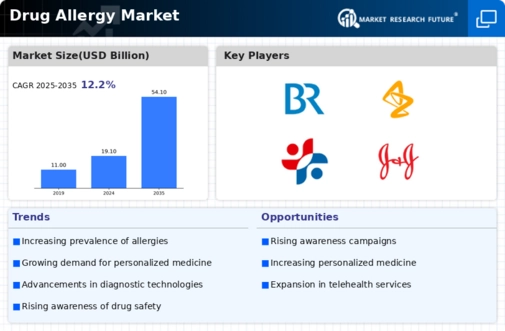Increased Awareness and Education
Increased awareness and education regarding drug allergies are pivotal drivers of the Global Drug Allergy Market Industry. Public health campaigns and educational initiatives by healthcare organizations have led to a better understanding of drug allergies among patients and healthcare professionals. This heightened awareness encourages individuals to seek medical advice and testing, thereby increasing the demand for allergy-related services and products. Furthermore, healthcare providers are more likely to implement preventive measures and treatment protocols, which could lead to improved patient outcomes. This trend is expected to sustain the market's growth trajectory, aligning with the anticipated CAGR of 9.93% from 2025 to 2035.
Growing Pharmaceutical Investments
The Global Drug Allergy Market Industry is benefiting from growing investments in pharmaceutical research and development. Companies are increasingly allocating resources to discover and develop new drugs aimed at treating drug allergies, which is essential for addressing the unmet medical needs of patients. This trend is driven by the rising prevalence of drug allergies and the demand for more effective treatments. As pharmaceutical firms innovate and expand their product portfolios, the market is expected to experience substantial growth. The anticipated increase in market value to 54.1 USD Billion by 2035 underscores the potential for lucrative opportunities in this sector.
Rising Incidence of Drug Allergies
The Global Drug Allergy Market Industry is witnessing a notable increase in the incidence of drug allergies, which is driving demand for effective diagnostic and therapeutic solutions. Reports indicate that approximately 10% of the population may experience some form of drug allergy during their lifetime. This rising prevalence necessitates advancements in allergy testing and treatment options, contributing to market growth. As awareness of drug allergies increases, healthcare providers are more likely to invest in specialized services and products, thereby expanding the market. The projected market value of 19.1 USD Billion in 2024 reflects this growing concern and the need for innovative solutions.
Regulatory Support for Allergy Management
Regulatory support for allergy management plays a crucial role in shaping the Global Drug Allergy Market Industry. Governments and health authorities are increasingly recognizing the need for stringent regulations and guidelines to ensure the safety and efficacy of allergy medications and treatments. This regulatory framework not only fosters innovation but also instills confidence among healthcare providers and patients. As a result, pharmaceutical companies are motivated to invest in research and development of new allergy therapies, which could enhance treatment options available in the market. This supportive environment is likely to contribute to the market's growth, reflecting the increasing focus on patient safety.
Advancements in Allergy Testing Technologies
Technological advancements in allergy testing are significantly influencing the Global Drug Allergy Market Industry. Innovations such as molecular diagnostics and skin testing have improved the accuracy and speed of allergy detection. These advancements not only enhance patient outcomes but also facilitate timely interventions, which are crucial in managing drug allergies. The integration of artificial intelligence in diagnostic tools further streamlines the process, making it more efficient. As the market evolves, the demand for these advanced testing technologies is expected to rise, contributing to the projected growth of the market to 54.1 USD Billion by 2035.














